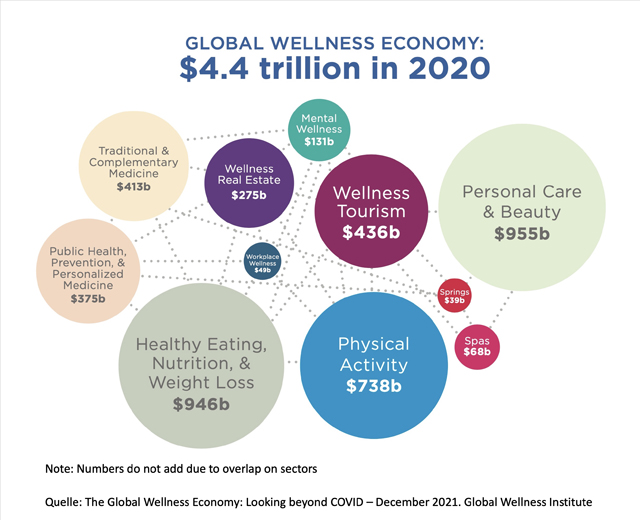Was ist Wellness und wie groß ist der Wellnessmarkt weltweit?
Das Global Wellness Institute hat den jährlichen Umsatz im weltweiten Wellnessmarkt auf 4,4 Billionen US-Dollar im Jahr 2020 beziffert. Einer der bedeutendesten Wellnssexperten aller Zeiten und Mitbegründer der von den USA ausgehenden Wellnessbewegung ist Dr. Donald B. Ardell. Er hat sich in einem Beitrag vom 16.12.2022 mit dieser Zahl auseinandergesetzt. Der folgende Text ist dem Real Wellness Report vom 17.12.2022 entnommen.
WHAT IS WELLNESS? HOW BIG ($) IS IT, GLOBALLY?
THE MEANING OF WELLNESS AND THE GWI
Do wellness consumers spend millions on wellness? Or, is it billions? How about trillions? What the heck--maybe it's quadrillions or even gazillions? What? A claim has been made that wellness represents a $4.4 trillion global economy. Wow.
If you were to encounter this claim, what might be your first reaction? I'll guess you'd like to know, What did they count as wellness? Also, how was the counting done and what credible independent source verified the count?
The Global Wellness Institute (GWI), based in Miami, first claimed wellness to be a multi-trillion dollar industry in 2014. Think about that number. A billion is 1.000 millions; it takes 1.000 billions to make a trillion. When GWI opened the bidding, so to speak, they put the global wellness economy at $3.4 trillion. By 2022, without any objectives by The Federal Reserve, they upped the figure to $4.4 trillion.
How long before GWI decides it's a quadrillion dollar global economy? (How many billions make a quadrillion? That would be a thousand trillion or, if you like, a million billion.) Give credit where it's due--GWI thinks big.
Speaking of big, GWI also offers The Wellness Moonshot. The goal is a world free of preventable disease. Not even The National Institutes of Health or the World Health Organization has dared such a bold goal. GWI acknowledges that this moonshot will require not one, but many incremental steps forward for humankind. If you're a Wellness Leader, you can participate by donating $10,000 or more to this project. Or, you can become a Global Strategic Partner with an annual gift of $50,000 or more, to GWI. Or, your organization can become a Sponsoring Partner for one year with a major gift to the Institute.
A bit more perspective might be helpful in assessing this $4.4 trillion figure. In 2022, the Department of Defense (DOD) budget was $1.64 trillion dollars. Do you really think it's plausible that global wellness spending on wellness is three times greater than what America spends on military operations, such as recruiting, training, health care and salaries for 1,358,500 active personnel?
Other comparisons to ponder:
• Spending on booze--beer, whiskey, wine and all else under the category of US alcohol spending in 2018 was $253.8 billion;
• All casino revenue in 2021 was but a paltry $45 billion; and
• Not even the US media and entertainment industry had reached the trillion dollar level ($717 billion in 2021).
For even more mind-boggling facts to promote appreciation of the number 4.4 trillion, consider that there are only 400 billion stars in our bloody galaxy, for God's sake. Furthermore, and, hold your proverbial horses, less than half as many (two trillion) stars exist in the entire universe as GWI asserts there are dollars spent in the global wellness economy.
Of course, this comparison is utterly irrelevant, if not nonsensical, but I thought you might find the comparison as amusing as I did writing it. Apologies to anyone who might have taken offense.
HOW GWI GOT TO $4.4 TRILLION
The key to GWI's claim of a $4.4 trillion global wellness economy is the way they count money spent on a remarkable range of businesses, products and services in a sweeping range of human endeavors. Terms such as generous, exaggerated or even preposterous capture the unreality of the multi-trillion dollar claim, in my humble opinion. This statement applies only if, by wellness, GWI views the term far more broadly than wellness descriptions commonplace half a century ago. I refer to my own works (including High Level Wellness: An Alternative to Doctors, Drugs and Disease by Rodale in 1977) and the prior promotion of the term by Halbert L. Dunn in the 50's and 60's, as well as wellness promoted by my contemporaries John Travis, Bill Hettler, Bob Allen and scores of others in books, articles and lectures. GWI wellness is also markedly different from wellness promotion in the 70's by at least a hundred state and metropolitan comprehensive health planning (CHP) agencies, as well as a wide range of company-based wellness programs, though the latter were then, as now, primarily preventative and medical in nature.
However, I want to be clear that there are, should and always will be varied ways of describing, promoting and pursuing wellbeing and promoting wellness. All should be welcomed, as well as carefully scrutinized before accepting one or more as better, or at least more personally appealing.
THE GWI WELLNESS CLAIM FURTHER EXPLAINED
A $4.4 trillion claim requires that wellness must be attributed to everything even tangentially associated with some form of health or medical services, commercial spas or other treatments, luxury vacations and the like.
The medicalization and commercialization of GWI's global wellness business claims represent a form of omnibus wellness. Much of what is counted consists in spending at luxury spa and tony resort settings, in good part for services and products that largely represent medical testing and self-indulgent foo foo treatments. Not much harm in the former (the latter is just a waste of time and money), but recognize that this is not wellness based upon personal agency and suitable, purposeful individual exertions or initiatives.
A global wellness economy of $4.4 trillion can only be weakly supported by including industries that have a tenuous association with REAL wellness. Again, REAL wellness is a philosophy and approach to lifestyle choices consistent with personal commitments to physical and mental wellbeing. REAL wellness is focused upon a conscious pursuit of reason (i.e., critical thinking), exuberance (i.e., meaning and purpose, joy, happiness, etc.), athleticism (i.e., sound nutrition and disciplined daily exercise) and liberty (i.e., personal freedoms).
REAL wellness has little connection with the products and services of the following industries in which total spending is employed to support exaggerated spending claims on wellness.
• Personal Care & Beauty ($955 billion)
• Wellness Tourism ($436 billion)
• Traditional & Complementary Medicine ($413 billion)
• Wellness Real Estate ($275 billion)
• Spas ($68 billion)
• Thermal/Mineral Springs ($39 billion)
This listing omits the other industry sectors in which spending is added to the global wellness claimed total spending:
• Public Health, Prevention, & Personalized Medicine ($375 billion)
• Mental Wellness ($131 billion)
• Workplace Wellness ($49 billion)
Most of the spending in these sectors, shown below, is medically curative and remedial in nature, not expressly promotive of initiatives for positive states of wellness focused on thriving and flourishing.

It is oddly curious that GWI has gone astray from their own statements about what wellness is and is not. In defining wellness, explicit attention is given to affirming that it is not a passive or static state but rather an active pursuit that is associated with intentions, choices and actions...toward an optimal state of health and wellbeing.
Wellness is an individual pursuit –
we have self-responsibility for our own choices,
behaviors and lifestyles –
but it is also significantly influenced
by the physical, social and
cultural environments in which we live.
PERSONAL CARE, BEAUTY AND WELLNESS?
In his latest book, Starry Messenger, Neil deGrasse Tyson gives the impression that he doesn't consider personal care and beauty spending worthy of consideration as initiatives that boost one's capacity for physical and mental functioning.
Based on the size of the cosmetics industry and the
larger beauty complex, visiting space aliens would
surely think we are ugly beyond repair, in persistent
need of improvements. We’ve designed household
tools to straighten curly hair and to curl straight hair.
We invented methods to replace missing hair. We use
chemical dyes to darken light hair and to lighten dark
hair. We don’t tolerate acne or skin blemishes of any
kind. We wear shoes that make us taller and perfumes
that make us smell better.We use makeup to accentuate
the good and suppress the bad elements of our
appearance. In the end, there’s not much real about our
appearance. The beauty we’re created is not even skin-
deep. It washes off in the shower...our space alien
would surely phone home and report further evidence
that there's no sign of intelligent life on Earth.
Tyson then returns to his astrobiology roots:
That which is objectively true or honestly authentic—
especially on Earth or in the heavens—tends to
possess a beauty of its own that transcends time,
place and culture…The truths of nature are rampant
with beauty and wonder, out to the largest of
measures of time and space...
(Source): Neil deGrasse Tyson, Starry Messenger – Cosmic Perspectives on Civilization, Henry Holt and Company, New York, pp. 11-13 and 167.
Despite reservations about the size of a global economy, I do wish even a fraction of GWI's grandiose boasts of spending on actual wellness were so. If spending on REAL wellness ever reached a level of one billion dollars (which alone seems to be a huge number), I would consider that a genuine moonshot that hit the mark.

Dr. Donald B. Ardell, Ph.D.
Editor/Publisher

























